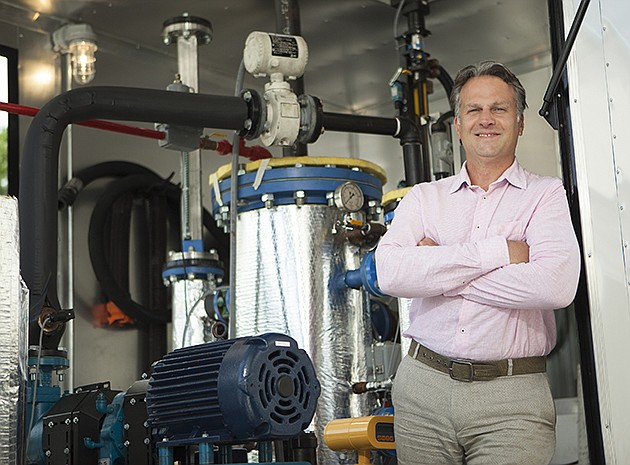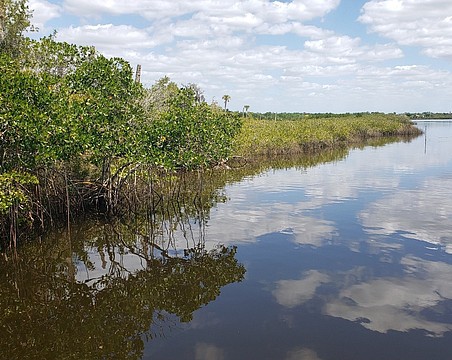Executive summary
Company. MagneGas Corp. Industry. Technology Key. Firm seeks to make good on its promising technology.
Technology that will change the world.
It's hard to find an up-and-coming company that doesn't make the claim, and Ermanno Santilli is no different.
Santilli's father, an Italian-born mathematician and physicist named Ruggero Santilli, founded MagneGas Corp. in 2007. His hope: Replace propane and acetylene with what he described as a more efficient, cleaner-burning, metal-cutting gas.
In the years since, the younger Santilli and his team have found other uses for the firm's MagneGas2-fueled plasma arc flow technology. The list runs a wide gamut, from sewage and sludge treatment to even creating energy from the dirty emissions of a coal plant.
Products using MagneGas2 became available in January, but a widespread rollout of products using all of MagneGas' full potential remains months, if not years away.
New ideas
Acetylene has been the fuel of choice for metal-cutting torches for more than a century. In the same way car owners are taking baby steps toward alternative fuel sources like electricity, metal-cutters are doing the same when it comes to parting ways with their tried and true, Santilli says. But it's a slow pace.
“We have a resistance to change,” says Santilli, who succeeded his father as CEO of MagneGas in 2012. “It's a slow growth. These companies we want as customers are not on the Internet, they are not on Amazon. For us, it's about word-of-mouth, it's about relationships.”
MagneGas isn't waiting, however. The company already has expanded applications for the gas, including a trial project in Indiana designed to cut the sterilization time of pig manure from months to almost instantly.
Santilli is most excited about is a new project where MagneGas2 could almost double the energy yield from coal burning.
“The gas we get is super-powerful,” Santilli says. “When it's oxidized, we're talking about reaching temperatures up to 10,500 degrees, comparable to 6,400 degrees in acetylene. The higher the flame temperature, the better the combustion.”
At twice the temperature of the sun's surface, MagneGas2 practically rips apart carbon dioxide, the primary pollutant known to affect climate change. That creates an emission the company says is cleaner than burning natural gas. The ignited gas can then be injected into the smoke emission from a coal-burning power plant, creating a second combustion, which could produce even more energy.
“Power plants like the one Duke Energy operates in Crystal River have to spend more than a billion dollars on scrubbers to keep a lot of that coal smoke out of the atmosphere,” Santilli says. “We could replace those scrubbers with our gas, and increase the energy efficiency of that coal from 35% to 45% or even 50%.”
Rough patches
With opportunities like that, Santilli's confidence is understandable.
“This is going to be one of the biggest shake-ups to the power industry since nuclear power,” Santilli says. “If you can take coal from 35% to 50% efficiency, it's a trillion-dollar business in America alone.”
However, MagneGas is far from a trillion-dollar corporation.
Eight years after it was founded, it's not even a profitable one. The firm has generated revenue of more than $5.1 million since 2010, but has posted a net loss totaling $23.5 million during that same period.
Nasdaq has twice threatened to delist MagneGas stocks after prices dropped below $1. In fact, the company has until June to turn around its share price, which closed last week at 82 cents.
Finding ways to effectively commercialize new technology can be a long process, says Daniel James Scott, a longtime local leader in technology startups who was named executive director of the Tampa Bay Technology Forum in January.
“Being an innovator is tough,” he says. “The folks at universities are really smart, inventing these cures and potions and lotions, but they just don't have the industry to fall back on. There is no executive picking up the mantle on their behalf, helping them gain access to new and fresh markets.”
That also can happen at the corporate level, especially with a newer company that hasn't fully realized the potential of the technology it possesses, Scott says. Many startups stay largely unknown, depending on angel investors and other venture capital to keep research and development funded. Yet firms that choose the route of public money, like MagneGas, are constantly exposed during that critical time, warts and all.
“I tell startups all the time that even with all the fancy metrics, analytics and frameworks that we have today, they are still no less risky than they were 10 years ago,” Scott says. “It's still a leap of faith.”
Don't miss out
Patient money remains the best money, Scott says. Jabil Circuit Inc. in St. Petersburg is a perfect example. Throughout the early 1990s, just as the electronic products services company was starting out, shares hovered around $1.
The dot-com bubble in 2000 shot share prices well above the $60 mark for a short time, but Jabil has since lived around the $20 mark for the past four years. It's one of the region's top five largest public companies with a market cap of more than $4.4 billion.
MagneGas, which trades on the Nasdaq using the symbol MNGA, is nowhere near that level, with a market cap a little more than $30 million. Staying patient and keeping an open mind, however, could help turn MagneGas into the next Jabil, one startup entrepreneur says.
“Most companies come in with a focus on a technology and a problem, but they don't know where the market is going,” says Taylor Wallace, co-founder and CEO of WeVue in Tampa. “It's often a hard sell for young entrepreneurs because they get so fixated on the idea they started with, they miss out on new opportunities.”
WeVue faced a situation just like that. Wallace and partner Saxon Baum developed a smartphone app to aggregate pictures and videos from concerts or sporting events. The app would then create single places through this new social media platform to see and hear everything from an event.
The problem, however, was having enough users at specific events to make the product worthwhile. It was a problem Wallace and Baum quickly realized they would not be able to solve.
“We instead found that partnering with a lot of business events, like holiday parties or conferences, created a lot of success for us,” Wallace says. “It became a way to focus on company culture through crowd sourcing, sharing content in a way that would've been cost-prohibitive before.”
Partnering for profits
In that regard, diversification remains a key component of Santilli's approach at MagneGas.
He's not willing to just sit and wait for markets like acetylene usage to shift. Instead, Santilli says it's worth the risk to throw possible applications out and see which ones stick.
“Just like any business, we're going to have 10 ideas, and maybe just three of them will work,” Santilli says. “And that is great. We have so many applications that we're thinking about and patents that we're working on, that we're really not worried.”
With annual losses well into seven digits, the current focus at MagneGas is to reduce costs by bringing in partners. MagneGas recently announced a partnership with two companies it didn't name, a deal that will help fund research and testing of its coal energy production project. The company has already spent more than $500,000 on that project.
MagneGas also is working on plans to better distribute its gas to more customers. That's why it acquired Equipment Sales & Service Inc. of Pinellas Park in October for $3 million.
“There are a lot of companies out there who are one-hit wonders, or even Hail Marys, where all their chips are in one place,” Santilli says. “We already have three different business lines, and even if we find success with just one of them, we know we can change the world.”

What is MagneGas?
MagneGas is a hydrogen-based fuel created through the company's plasma arc flow technology.
Liquid waste, such as sewage, animal manure or even used antifreeze, flows through a submerged electric arc between two electrodes. As the arc decomposes the liquid molecules into atoms, it forms a plasma around the electrodes that reach temperatures above 10,000 degrees Fahrenheit.
When the plasma is moved away from the electrodes, MagneGas rises to the surface, which can then be collected and used. MagneGas can be used for everything from transportation fuel to metal cutting to even cooking and heating.
This story was updated to reflect new information about the timing of MagneGas products.







